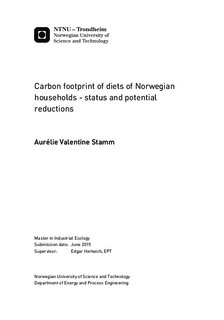Carbon footprint of diets of Norwegian households - status and potential reductions
Abstract
The present work aims at quantifying the current carbon footprint of diets of average Norwegian households with a holistic perspective, and assessing various ways to reduce it. The scope of the research comprises food consumed and food-related activities happening at home, including food transport, storage and preparation. After an introduction of the context of the research, its research question, goal and scope, the report reviews existing literature. It then presents the methods used for its own analysis, and its results. The analysis is then discussed, and the work concludes with a brief review of its main findings and challenges. Two models were built separately. One assesses the carbon footprint of food consumption as well as food waste, and the other makes the same assessment for food supply. Both models served to calculate their associate system s current carbon footprint, and to build scenarios to assess reduction potentials. The analysis finds higher emissions embodied in food consumption than in food waste and in food supply. An average Norwegian has a diet carrying emissions of 1233 kg CO2-e per year, to which wasted food adds embodied emissions of 114 kg CO2-e per year, and for which food transport, storage and preparation at home carry emissions of 203 kg CO2-e per year. Main limitations of this analysis comes from uncertainties lying in the data. The present work calls for further research to lower the uncertainty level, and to assess the system s footprint on other impact categories.
